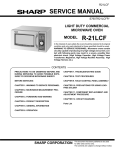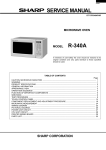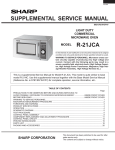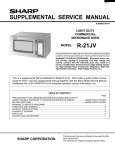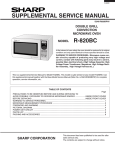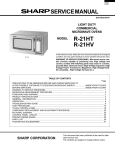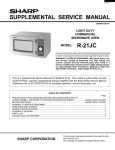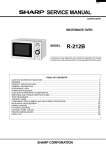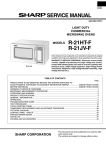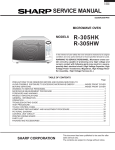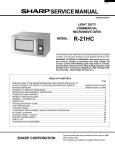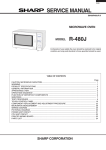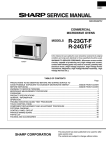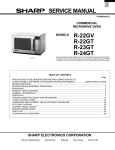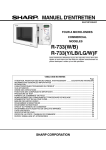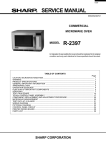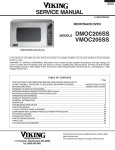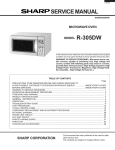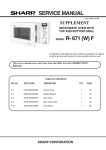Download Sharp R-21AT Service manual
Transcript
R-21AT SERVICE MANUAL SX802R21ATPKK COMMERCIAL MICROWAVE OVEN 1000W/ R-21AT ON DEF NO. X2 CHECK MODEL R-21AT In interests of user-safety the oven should be restored to its original condition and only parts identical to those specified should be used. TABLE OF CONTENTS Page SERVICING ................................................................................................................. INSIDE FRONT COVER CAUTION, MICROWAVE RADIATION ............................................................................................................. 1 WARNING .......................................................................................................................................................... 1 PRODUCT SPECIFICATIONS ......................................................................................................................... 2 GENERAL INFORMATION ................................................................................................................................ 2 APPEARANCE VIEW ....................................................................................................................................... 3 OPERATION SEQUENCE ................................................................................................................................ 4 FUNCTION OF IMPORTANT COMPONENTS ................................................................................................ 5 TROUBLESHOOTING GUIDE .......................................................................................................................... 6 TEST PROCEDURE ......................................................................................................................................... 7 TOUCH CONTROL PANEL ASSEMBLY ........................................................................................................ 13 COMPONENT REPLACEMENT AND ADJUSTMENT PROCEDURE ........................................................... 20 MICROWAVE MEASUREMENT .................................................................................................................... 25 WIRING DIAGRAM ......................................................................................................................................... 26 PICTORIAL DIAGRAM ................................................................................................................................... 27 CONTROL PANEL CIRCUIT ........................................................................................................................... 28 PRINTED WIRING BOARD ............................................................................................................................. 29 PARTS LIST ................................................................................................................................................... 30 SHARP CORPORATION R-21AT SERVICING WARNING TO SERVICE PERSONNEL Microwave ovens contain circuitry capable of producing very high voltage and current. Contact with following parts will result in electrocution. High voltage capacitor, High voltage transformer, Magnetron, High voltage rectifier, High voltage fuse, High voltage harness. REMEMBER TO CHECK 3D 1) Disconnect the supply. 2) Door opened, and wedged open. 3) Discharge high voltage capacitor. WARNING: AGAINST THE CHARGE OF THE HIGH-VOLTAGE CAPACITOR. The high-voltage capacitor remains charged about 60 seconds after the oven has been switched off. Wait for 60 seconds and then short-circuit the connection of the high-voltage capacitor (that is, of the connecting lead of the high-voltage rectifier) against the chassis using a screwdriver with an insulated handle. Sharp recommend that wherever possible fault-finding is carried out with the supply disconnected. In some cases, it may be necessary to connect the supply with the cover removed to carry out fault investigation in the circuitry. In such cases, the high voltage circuit should be disabled as described below to reduce the hazards:Carry out 3D checks (see above) Disconnect the supply leads from the high voltage transformer, making a note of the polarity. Insulate the connectors, ensuring they are positioned away from the transformer and fastened there. Connect any relevant test equipment e.g. voltmeter. Reconnect the oven to the supply, then close the door. Note the results of the test, taking care to keep clear of the operational oven. Carry out 3D checks (see above). Reconnect the leads to the transformer. Take care to observe correct polarity. Carry out 4R checks (see below). Microwave ovens should not be used without load. To test for the presence of microwave energy within a cavity, place a cup of cold water on the ceramic shelf, close the door and set the microwave timer for one (1) minute, set the power level to HIGH (100%) and push the start key. When the one (1) minute has elapsed (timer at zero) carefully check that the water is now hot. AFTER REPAIR REMEMBER TO CHECK 4R 1) 2) 3) 4) Reconnect all leads removed from components during testing. Replace the outer case (cabinet). Reconnect the supply. Run the oven. Check all functions. When all service work is completed and the oven is fully assembled, the microwave power output should be checked and microwave leakage test should be carried out. IMPORTANT: If the oven becomes inoperative because of a blown fuse M10A Fuse, check the monitored 1st. interlock switch and monitor switch before replacing the fuse M10A. WARNING: WIRING / RE-WIRING RE-WIRING Before carrying out any work; carry out 3D checks. 1) Disconnect the power supply. 2) Open the door and wedge open. 3) Discharge the high voltage capacitor. 1) Wires must not touch: a) High voltage parts: b) Parts that become hot. c) Sharp edges d) Movable parts 2) Positive lock connectors are fitted correctly. 3) Wires are connected correctly as per pictorial diagram. 4) Now wire leads are trapped by the outer wrap. R-21AT SERVICE MANUAL PRODUCT SPECIFICATIONS GENERAL INFORMATION COMMERCIAL MICROWAVE OVEN APPEARANCE VIEW R-21AT GENERAL IMPORTANT INFORMATION This Manual has been prepared to provide Sharp Corp. Service engineers with Operation and Service Information. It is recommended that service engineers carefully study the entire text of this manual, so they will be qualified to render satisfactory customer service. CAUTION MICROWAVE RADIATION OPERATING SEQUENCE FUNCTION OF IMPORTANT COMPONENTS SERVICING AND TROUBLESHOOTING GUIDE Service engineers should not be exposed to the microwave energy which may radiate from the magnetron or other microwave generating devices if it is improperly used or connected. All input and output microwave connections, waveguides, flanges and gaskets must be secured. Never operate the device without a microwave energy absorbing load attached. Never look into an open waveguide or antenna while the device is energized. WARNING Never operate the oven until the following points are ensured. (A) The door is tightly closed. (B) The door brackets and hinges are not defective. (C) The door packing is not damaged. (D) The door is not deformed or warped. (E) There is not any other visible damage with the oven. Servicing and repair work must be carried out only by trained service engineers. TEST PROCEDURE TOUCH CONTROL PANEL COMPONENT REPLACEMENT AND ADJUSTMENT PROCEDURE MICROWAVE MEASUREMENT WIRING DIAGRAM All the parts marked "*" on parts list are used at voltages more than 250V. Removal of the outer wrap gives access to potentials above 250V. All the parts marked "∆" on parts list may cause undue microwave exposure, by themselves, or when they are damaged, loosened or removed. SHARP CORPORATION OSAKA, JAPAN 1 PARTS LIST R-21AT PRODUCT DESCRIPTION SPECIFICATION ITEM DESCRIPTION Power Requirements Power Output Case Dimensions Cooking Cavity Dimensions Control Complement Set Weight 230 - 240 Volts 50 Hertz Single phase, 3 wire earthed 1000 W nominal of RF microwave energy (measured by method of IEC 705) Operating frequency 2450 MHz Width 520 mm Height 309 mm including foot Depth 406 mm Width 351 mm Height 211 mm Depth 372 mm Touch Control System Timer (0 - 99 minutes and 99 seconds) Microwave Power for Variable Cooking Repetition Rate; P-HI ........................................... Full power throughout the cooking time P-90 ............................................................. approx. 90% of Full Power P-80 ............................................................. approx. 80% of Full Power P-70 ............................................................. approx. 70% of Full Power P-60 ............................................................. approx. 60% of Full Power P-50 ............................................................. approx. 50% of Full Power P-40 ............................................................. approx. 40% of Full Power P-30 ............................................................. approx. 30% of Full Power P-20 ............................................................. approx. 20% of Full Power P-10 ............................................................. approx. 10% of Full Power P-0 ............................................. No power throughout the cooking time DOUBLE QUANTITY pad EXPRESS DEFROST pad Number pads SELECT TIME pad STOP/CLEAR pad SELECT POWER pad START pad SET pad CHECK pad SIGNAL pad Approx. 18 kg GENERAL INFORMATION WARNING THIS APPLIANCE MUST BE EARTHED IMPORTANT THE WIRES IN THIS MAINS LEAD ARE COLOURED IN ACCORDANCE WITH THE FOLLOWING CODE: GREEN-AND-YELLOW BLUE BROWN : EARTH : NEUTRAL : LIVE 2 R-21AT APPEARANCE VIEW OVEN 10 1. Oven light 2. Ceramic shelf 3. Control panel 9 4. Cavity face plate 5. Door latch openings 6. Door latches 7. Door hinges 8. Door seals and sealing surfaces 9. Door handle 10.Oven door with see-through window 11.Air ventilation cover and openings 12.Power supply cord 13.Air intake openings 14.Outer case cabinet 7 1 12 11 2 13 14 6 8 4 5 3 TOUCH CONTROL PANEL 1. 2. 3. 4. Digital Readout DOUBLE QUANTITY pad EXPRESS DEFROST pad Number pads for time and memory programming 5. SELECT TIME pad 6. STOP/CLEAR pad; touch to stop operation of oven and clear remaining heating time 7. SELECAT POWER pad for setting variable power level 8. START pad; touch to operate oven after door is closed and time is set 9. SET pad for setting memory 10.CHECK pad for checking memory 11.SIGNAL pad for setting signal sound 1 ON DEF NO. X2 CHECK 2 3 4 5 7 9 10 3 6 8 11 R-21AT OPERATION SEQUENCE OFF CONDITION 6-1. When the oven door is opened during or after the cycle of a cooking program, the 1st. interlock switch, latch switch and 2nd. interlock relay control switch must open their contacts first. After that the contacts (COM-NC) of the monitor switch can be closed. 6-2. When the oven door is closed, the contacts (COMNC) of the monitor switch must be opened. After that the contacts of the 1st. interlock switch, latch switch and 2nd. interlock relay control switch are closed. 6-3. When the oven door is opened and the contacts of the 1st. latch switch, 2nd. latch switch and the relay RY2 remain closed, the fuse M10A will blow, because the monitor switch is closed and a short circuit is caused. Closing the door activates the 1st. latch switch, 2nd. latch switch and stop switch. IMPORTANT: When the oven door is closed, the contacts COM-NC of the monitor switch must be open. When the microwave oven is plugged in a wall outlet (230 - 240V 50Hz), the line voltage is supplied to the noise filter and the control unit. Figure O-1 on page 26 1. The oven display will show . . MICROWAVE COOKING CONDITION POWER LEVEL P-0 TO P-90 COOKING Program desired cooking time by touching SELECT TIME pad and the NUMBER pads. When the START pad is touched, the following operations occur: When Variable Cooking Power is programmed, the line voltage is supplied to the power transformer intermittently through the contacts of relay (RY-2) which is operated by the control unit within a 32 second time base. Microwave power operation is as follows: Figure O-2 on page 26 RELAY RY-2 RY-3 CONNECTED COMPONENTS power transformer oven lamp/antenna motor/fan motor VARI-MODE Power 10(P-HI) (100% power) Power 9(P-90) (approx. 90% power) Power 8(P-80) (approx. 80% power) Power 7(P-70) (approx. 70% power) Power 6(P-60) (approx. 60% power) Power 5(P-50) (approx. 50% power) Power 4(P-40) (approx. 40% power) Power 3(P-30) (approx. 30% power) Power 2(P-20) (approx. 20% power) Power 1(P-10) (approx. 10% power) Power 0(P-0) (0% power) 1. The line voltage is supplied to the primary winding of the high voltage transformer. The voltage is converted to about 3.3 volts A.C. output on the filament winding and high voltage of approximately 2300 volts A.C. on the secondary winding. 2. The filament winding voltage (3.3 volts) heats the magnetron filament and the high voltage (2000 volts) is sent to the voltage doubling circuit, where it is doubled to negative voltage of approximately 4000 volts D.C.. 3. The 2450 MHz microwave energy produced in the magnetron generates a wave length of 12.24 cm. This energy is channelled through the waveguide (transport channel) into the oven cavity, where the food is placed to be cooked. 4. When the cooking time is up, a signal tone is heard and the relays RY2 + RY3 go back to their home position. The circuits to the oven lamp, high voltage transformer, fan motor and antenna motor are cut off. 5. When the oven door is opened during a cooking cycle, the switches come to the following condition. Switch Contact 1st. interlock switch Latch switch 2nd. interlock relay control switch COM-NO COM-NO Condition During Oven Door Cooking Open(No cooking) Closed Opened Closed Opened COM-NO Closed Opened Monitor Switch COM-NC Opened Closed Note: The circuit to the high voltage transformer, fan motor, oven lamp and antenna motor are cut off when the 1st. interlock switch, latch switch and 2nd. interlock relay control switch are made open. Shown in the display is remaining time. 6. MONITOR SWITCH CIRCUIT The monitor switch is mechanically controlled by the oven door, and monitors the operation of the 1st. interlock switch. 4 ON TIME 32 sec. OFF TIME 0 sec. 30 sec. 2 sec. 26 sec. 6 sec. 24 sec. 8 sec. 22 sec. 10 sec. 18 sec. 14 sec. 16 sec. 16 sec. 12 sec. 20 sec. 8 sec. 24 sec. 6 sec. 26 sec. 0 sec. 32 sec. The ON/OFF time ratio does not correspond with the percentage of microwave power, because approx. 2 seconds are needed for heating of the magnetron filament. R-21AT FUNCTION OF IMPORTANT COMPONENTS DOOR OPEN MECHANISM HIGH VOLTAGE FUSE 0.75A The door is opened by grasping the door handle, refer to Figure D-1. When the door handle is grasped, the handle lever is pulled. And then the upper and lower latch heads are moved upward by the handle lever, and they are released from the latch hook. Now the door will open. The high voltage fuse blows when the high voltage rectifier or the magnetron is shorted. THERMAL CUT-OUT 145˚C (MAGNETRON) This thermal cut-out protects the magnetron against overheating. If the temperature goes up higher than 145˚C because the fan motor is interrupted or the ventilation openings are blocked, the thermal cut-out will open and line voltages to the high voltage transformer will be cut off and the operation of the magnetron will be stopped. The thermal cut-out will not resume. Latch Head Handle Lever Latch Hook THERMAL CUT-OUT 125˚C (OVEN) Door Handle The thermal cut-out located on the top of the oven cavity is designed to prevent damage to the oven if the food in the oven catches fire due to over heating produced by improper setting of the cooking time or failure of control unit. Under normal operation, the oven thermal cut-out remains closed. However, when abnormally high temperatures are reached within the oven cavity, the oven thermal cut-out will open at 125˚C causing the oven to shut down. The thermal cut-out will not resume. Latch Switch Lever A 1st. Interlock Switch Latch Lever Latch Switch Lever B Latch Head Latch Switch Lever C Monitor Switch 2nd. Interlock Relay Control Switch Latch Switch MONITOR RESISTOR The monitor resistor prevents the fuse M10A bursting when the fuse M10A blows due to the operation of the monitor switch. Figure D-1. Door Open Mechanism 1ST. INTERLOCK SWITCH, LATCH SWITCH AND 2ND. INTERLOCK RELAY CONTROL SWITCH NOISE FILTER 1. When the oven door is closed, the contacts (COM-NO) of each switch must be closed. 2. When the oven door is opened, the contacts (COMNO) of each switch must be opened. The noise filter assembly prevents radio frequency interference that might flow back in the power circuit. MONITOR SWITCH The antenna motor rotates the stirrer antenna located on the bottom of the oven cavity, so that the food on the ceramic shelf is cooked evenly during cooking. The antenna motor may turn in either direction. ANTENNA MOTOR 1. When the door is closed, the contacts (COM-NC) must be opened. 2. When the door is opened, the contacts (COM-NC) must be closed. 3. If the oven door is opened and the contacts (COM-NO) of the 1st. interlock switch fail to open, the fuse M10A blows immediately after closing the contacts (COMNC) of the monitor switch. COOLING FAN MOTOR The cooling fan motor drives a blade which draws external cool air. This cool air is directed through the air vanes surrounding the magnetron and cools the magnetron. This air is channelled through the oven cavity to remove steam and vapors given off from the heating food. It is then exhausted through the exhausting air vents at the oven cavity. CAUTION: BEFORE REPLACING A BLOWN FUSE M10A TEST THE 1ST. INTERLOCK SWITCH, MONITOR SWITCH AND MONITOR RESISTOR FOR PROPER OPERATION. (REFER TO CHAPTER “TEST PROCEDURE”). FUSE M10A 250V 1. If the wire harness or electrical components are shortcircuited, this fuse blows to prevent an electric shock or fire hazard. 2. This fuse blows when the 1st. interlock switch remain closed with the oven door open and when the contacts (COM-NC) of monitor switch closes. 5 R-21AT TROUBLESHOOTING GUIDE Home fuse or circuit breaker blows when power cord is plugged into wall outlet. OFF CONDITION Fuse M10A blows when power cord is plugged into wall receptacle. . does not appear in display when power cord is first plugged into wall outlet. Oven lamp does not light when door is opened. Oven lamp lights but fan motor and antenna motor do not operate. COOKING CONDITION Oven does not go into cook cycle when START pad is touched. Oven seems to be operating but little or no heat is produced in oven load. (Food incompletely cooked or not cooked at all at end of cook cycle.) Oven goes into a cook cycle but extremely uneven heating is produced in oven load (food). Oven does not cook properly when programmed for Cooking Power 5 mode. (Operates properly on Cooking Power 10 (HIGH) mode.) ERROR MODE "EE9" Maximum time is exceeded. 6 DIRTY OVEN CAVITY MISADJUSTMENT SWITCH LOW VOLTAGE WRONG OPERATION SHORTED IN POWER CORD SHORT OR OPENED WIRING OVEN LAMP OR SOCKET EXCEED MAX. HEATING TIME FOIL PATTERN ON P.W.B. RELAY (RY3) K L M M N CK RE RE RECK CK CKCK KEY UNIT RELAY (RY2) J TOUCH CONTROL PANEL ANTENNA MOTOR I FUSE M10A NOISE FILTER COOLING FAN MOTOR THERMAL CUT-OUT MONITOR SWITCH 2ND. INTERLOCK RELAY CONTROL SWITCH LATCH SWITCH HIGH VOLTAGE CAPACITOR 1ST. INTERLOCK SWITCH PROBLEM H.V. RECTIFIER ASSEMBLY CONDITION HIGH VOLTAGE TRANSFORMER POSSIBLE CASE AND DEFECTIVE PARTS A B C D E E E E F G H I MAGNETRON TEST PROCEDURE HIGH VOLTAGE FUSE When troubleshooting the microwave oven, it is helpful to follow the Sequence of Operation in performing the checks. Many of the possible causes of trouble will require that a specific test be performed. These tests are given a procedure letter which will be found in the “Test Procedure” section. R-21AT TEST PROCEDURES PROCEDURE LETTER A MAGNETRON TEST COMPONENT TEST NEVER TOUCH ANY PART IN THE CIRCUIT WITH YOUR HAND OR AN INSULATED TOOL WHILE THE OVEN IS IN OPERATION. CARRY OUT 3D CHECKS. Isolate the magnetron from high voltage circuit by removing all leads connected to filament terminal. To test for an open circuit filament use an ohmmeter to make a continuity test between the magnetron filament terminals, the meter should show a reading of less than 1 ohm. To test for short filament to anode condition, connect ohmmeter between one of the filament terminals and the case of the magnetron (ground). This test should be indicated an infinite resistance. If a low or zero resistance reading is obtained then the magnetron should be replaced. MICROWAVE OUTPUT POWER (1 litre load) The following test procedure should be carried out with the microwave oven in a fully assembled condition (outer case fitted). Microwave output power from the magnetron can be measured by way of IEC 705, i.e. it is measured by how much power the water load can absorb. To measure the microwave output power in the microwave oven, the relation of calorie and watt is used. When P(W) heating works for t(second), approximately P x t/4.187 calorie is generated. On the other hand, if the temperature of the water with V(ml) rises ∆T (°C) during this microwave heating period, the calorie of the water is V x ∆T. The formula is as follows; P x t / 4.187 = V x ∆ T P (W) = 4.187 x V x ∆T / t Our condition for water load is as follows: Room temperature ........... around 20°C Power supply Voltage .............. Rated voltage Water load.................................. 1000 g Initial temperature .............................. 10±2°C Heating time .............................. 42 sec. P = 100 x ∆T Measuring condition: 1. Container The water container must be a cylindrical borosilicate glass vessel having a maximum material thickness of 3 mm and an outside diameter of approximately 190 mm. 2. Temperature of the oven and vessel The oven and the empty vessel are at ambient temperature prior to the start the test. 3. Temperature of the water The initial temperature of the water is (10±2)°C. 4. Select the initial and final water temperature so that the maximum difference between the final water temperature and the ambient temperature is 5°C. 5. Select stirring devices and measuring instruments in order to minimize addition or removal of heat. 6. The graduation of the thermometer must be scaled by 0.1°C at minimum and be an accurate thermometer. 7. The water load must be (1000±5) g. 8. “t” is measured while the microwave generator is operating at full power. Magnetron filament heatup time is not included. NOTE: The operation time of the microwave oven is “t + 2” sec. (2 sec. is magnetron filament heat-up time.) Measuring method: 1. Measure the initial temperature of the water before the water is added to the vessel. (Example: The initial temperature T1 = 11°C) 2. Add the 1 litre water to the vessel. 3. Place the load on the centre of the shelf. 4. Operate the microwave oven at HIGH for the temperature of the water rises by a value ∆ T of (10 ± 2) K. 5. Stir the water to equalize temperature throughout the vessel. 6. Measure the final water temperature. (Example: The final temperature T2 = 21°C) 7. Calculate the microwave power output P in watts from above formula. 7 R-21AT TEST PROCEDURES PROCEDURE LETTER COMPONENT TEST Initial temperature .................................................................................................. T1 = 11°C Temperature after (42 + 2) = 44 sec ...................................................................... T2 = 21°C Temperature difference Cold-Warm ...................................................................... ∆T1 = 10˚C Measured output power The equation is “P = 100 x ∆T” ................................................ P = 100 x 10°C = 1000 Watts JUDGMENT: The measured output power should be at least ± 15 % of the rated output power. CAUTION: 1°C CORRESPONDS TO 100 WATTS. REPEAT MEASUREMENT IF THE POWER IS INSUFFICIENT. 1000g 1000g 1000g T1˚C T2˚C Heat up for 44 sec B HIGH VOLTAGE TRANSFORMER TEST WARNING: High voltage and large currents are present at the secondary winding and filament winding of the high voltage transformer. It is very dangerous to work near this part when the oven is on. NEVER make any voltage measurements of the high-voltage circuits, including the magnetron filament. CARRY OUT 3D CHECKS. Disconnect the leads to the primary winding of the high voltage transformer. Disconnect the filament and secondary winding connections from the rest of the HV circuitry. Using an ohmmeter, set on a low range, it is possible to check the continuity of all three windings. The following readings should be obtained:a. Primary winding ................................ approximately 1.3 Ω b. Secondary winding ............................ approximately 86 Ω c. Filament winding......................................... less than 1 Ω If the readings obtained are not stated as above, then the high voltage transformer is probably faulty and should be replaced. CARRY OUT 4R CHECKS. C HIGH VOLTAGE RECTIFIER ASSEMBLY TEST B CARRY OUT 3D CHECKS. C HIGH VOLTAGE RECTIFIER Isolate the high voltage rectifier assembly from the HV circuit. The high voltage rectifier can be tested using an ohmmeter set to its highest range. Connect the ohmmeter across the terminal B+C of the high voltage rectifier and note the reading obtained. Reverse the meter leads and note this second reading. The normal resistance is infinite in one direction and more than 100 kΩ in the other direction. CARRY OUT 4R CHECKS. NOTE: FOR MEASUREMENT OF THE RESISTANCE OF THE RECTIFIER, THE BATTERIES OF THE MEASURING INSTRUMENT MUST HAVE A VOLTAGE AT LEAST 6 VOLTS, BECAUSE OTHERWISE AN INFINITE RESISTANCE MIGHT BE SHOWN IN BOTH DIRECTIONS. D HIGH VOLTAGE CAPACITOR TEST CARRY OUT 3D CHECKS. A. Isolate the high voltage capacitor from the circuit. B. Continuity check must be carried out with measuring instrument which is set to the highest resistance range. C. A normal capacitor shows continuity for a short time (kick) and then a resistance of about 10MΩ after 8 R-21AT TEST PROCEDURES PROCEDURE LETTER COMPONENT TEST it has been charged. D. A short-circuited capacitor shows continuity all the time. E. An open capacitor constantly shows a resistance about 10 MΩ because of its internal 10MΩ resistance. F. When the internal wire is opened in the high voltage capacitor shows an infinite resistance. G. The resistance across all the terminals and the chassis must be infinite when the capacitor is normal. If incorrect reading are obtained, the high voltage capacitor must be replaced. CARRY OUT 4R CHECKS. E SWITCH TEST CARRY OUT 3D CHECKS. Isolate the switch to be tested and using an ohmmeter check between the terminals as described in the following table. Table: Terminal Connection of Switch Plunger Operation COM to NO COM to NC Released Depressed Open circuit Short circuit Short circuit Open circuit COM; Common terminal, NO; Normally open terminal NC; Normally close terminal If incorrect readings are obtained, make the necessary switch adjustment or replace the switch. CARRY OUT 4R CHECKS. F THERMAL CUT-OUT TEST CARRY OUT 3D CHECKS. Disconnect the leads from the terminals of the thermal cut-out. Then using an ohmmeter, make a continuity test across the two terminals as described in the below. Table: Thermal Cut-out Test Parts Name Temperature of "ON" condition (closed circuit). (˚C) Temperature of "OFF" condition (open circuit). (˚C) Indication of ohmmeter (When room temperature is approx. 20˚C.) Thermal cut-out 125˚C This is not resetable type. Above 125˚C Closed circuit Thermal cut-out 145˚C This is not resetable type. Above 145˚C Closed circuit If incorrect readings are obtained, replace the thermal cut-out. An open circuit thermal cut-out (MG) indicates that the magnetron has overheated, this may be due to resistricted ventilation, cooling fan failure or a fault condition within the magnetron or HV. circuit. An open circuit thermal cut-out (OVEN) indicates that the food in the oven cavity may catch fire, this may be due to over heating produced by improper setting of the cooking timer or failure of the control panel. CARRY OUT 4R CHECKS. G BLOWN FUSE M10A CARRY OUT 3D CHECKS. If the fuse M10A is blown when the door is opened, check the 1st. interlock switch, monitor switch and monitor resistor. If the fuse M10A is blown, there could be a short or ground in electrical parts or wire harness. Check them and replace the defective parts or repair the wire harness. CARRY OUT 4R CHECKS. CAUTION: Only replace fuse M10A with the correct value replacement. 9 R-21AT TEST PROCEDURES PROCEDURE LETTER H NOISE FILTER TEST COMPONENT TEST L N MEASURING POINTS Between N and L Between terminal N and WHITE Between terminal L and RED INDICATION OF OHMMETER Approx. 680 kΩ Short circuit Short circuit If incorrect readings are absorbed, replace the noise filter unit. DISCHARGE RESISTOR 680 kΩ NOISE SUPPRESSION COIL LINE CROSS CAPACITOR 0.068µF/ AC 250V LINE BYPASS CAPACITOR 0.0033µF/ AC 250V CARRY OUT 4R CHECKS. I FUSE M10A NOISE FILTER CARRY OUT 3D CHECKS. Disconnect the leads from the terminals of noise filter. Using an ohmmeter, check between the terminals as described in the following table. LINE BYPASS CAPACITOR 0.0033µF/ AC 250V DISCHARGE RESISTOR 10MΩ MOTOR WINDING TEST CARRY OUT 3D CHECKS. Disconnect the leads from the motor. Using an ohmmeter, check the resistance between the two terminals as described in the table below. Table: Resistance of Motor Motors Resistance Fan motor Approximately 219 Ω Antenna motor Approximately 11 kΩ If incorrect readings are obtained, replace the motor. CARRY OUT 4R CHECKS. J HIGH VOLTAGE FUSE TST CARRY OUT 3D CHECKS. If the high voltage fuse is blown, there could be a short in the high voltage rectifier or the magnetron. Check them and replace the defective parts and the high voltage fuse. CARRY OUT 4R CHECKS. CAUTION: K Only replace high voltage fuse with the correct value replacement. TOUCH CONTROL PANEL ASSEMBLY TEST The touch control panel consists of circuits including semiconductors such as LSI, ICs, etc. Therefore, unlike conventional microwave ovens, proper maintenance can not be performed with only a voltmeter and ohmmeter. In this service manual, the touch control panel assembly is divided into two units, Control Unit and Key Unit and troubleshooting by replacement is described according to the symptoms indicated. 1. Key Unit Note : Check key unit ribbon connection before replacement. The following symptoms indicate a defective key unit. Replace the key unit. a) When touching the pads, a certain pad produces no signal at all. b) When touching a number pad, two figures or more are displayed. c) When touching the pads, sometimes a pad produces no signal. 2. Control Panel The following symptoms indicate a defective control unit. Before replacing the control unit. perform the key unit test (Procedure L) to determine if control unit is faulty. 2-1 In connection with pads a) When touching the pads, a certain group of pads do not produce a signal. b) When touching the pads, no pads produce a signal. 2-2 In connection with indicators a) At a certain digit, all or some segments do not light up. b) At a certain digit, brightness is low. c) Only one indicator does not light up. d) The corresponding segments of all digits do not light up; or they continue to light up. 10 R-21AT TEST PROCEDURES PROCEDURE LETTER COMPONENT TEST e) Wrong figure appears. f) A certain group of indicators do not light up. g) The figure of all digits flicker. 2-3 Other possible troubles caused by defective control unit. a) Buzzer does not sound or continues to sound. b) Clock does not operate properly. c) Cooking is not possible. L KEY UNIT TEST If the display fails to clear when the STOP/CLEAR pad is depressed, first verify the flat ribbon cable is marking good contact, verify that the door sensing switch (stop switch) operates properly; that is the contacts are closed when the door is closed and open when the door is open. If the door sensing switch (stop switch) is good, disconnect the flat ribbon cable that connects the key unit to the control unit and make sure the door sensing switch is closed (either close the door or short the door sensing switch connecter). Use the Key unit matrix indicated on the control panel schematic and place a jumper wire between the pins that correspond to the STOP/CLEAR pad marking momentary contact. If the control unit responds by clearing with a beep the key unit is faulty and must be replaced. If the control unit does not respond, it is a faulty and must be replaced. If a specific pad does not respond, the above method may be used (after clearing the control unit) to determine if the control unit or key pad is at fault. G1 G2 G3 17 G9 18 G10 19 G11 20 G12 G4 G5 G6 G7 G8 7 SELECT POWER DOUBLE QUANTITY START SET 8 SELECT TIME EXPRESS DEFROST STOP/ CLEAR CHECK 9 0 15 16 5 6 13 14 3 4 11 12 1 SIGNAL 2 CARRY OUT 4R CHECKS. M RELAY TEST CARRY OUT 3D CHECKS. Remove the outer case and check voltage between Pin Nos. 3 and 7 of the 3 pin connector (A) on the control unit with an A.C. voltmeter. The meter should indicate 230-240 volts, if not check oven circuit. Relay Test Check voltage at the relay coil with a D.C. voltmeter during the microwave cooking operation. DC. voltage indicated .......... Defective relay. DC. voltage not indicated .... Check diode which is connected to the relay coil. If diode is good, control unit is defective. RELAY SYMBOL OPERATIONAL VOLTAGE CONNECTED COMPONENTS RY2 Approx. 18.0V D.C. High voltage transformer RY3 Approx. 18.0V D.C. Oven lamp / Antenna motor / Fan motor CARRY OUT 4R CHECKS. 11 R-21AT TEST PROCEDURES PROCEDURE LETTER COMPONENT TEST N PROCEDURES TO BE TAKEN WHEN THE FOIL PATTERN ON THE PRINTED WIRING BOARD (PWB) IS OPEN To protect the electronic circuits, this model is provided with a fine foil pattern added to the input circuit on the PWB, this foil pattern acts as a fuse. If the foil pattern is open, follow the troubleshooting guide given below for repair. Problem: POWER ON, indicator does not light up. CARRY OUT 3D CHECKS. STEPS OCCURRENCE 1 The rated AC voltage is not present at Power terminal of CPU connector (CN-A). Check supply voltage and oven power cord. CAUSE OR CORRECTION 2 The rated AC voltage is present at primary side of low voltage transformer. Low voltage transformer or secondary circuit defective. Check and repair. 3 Only pattern at "a" is broken. *Insert jumper wire J1 and solder. (CARRY OUT 3D CHECKS BEFORE REPAIR) 4 Pattern at "a" and "b" are broken. *Insert the coil RCILF2003YAZZ between "c" and "d". (CARRY OUT 3D CHECKS BEFORE REPAIR) (TB1) 7 b a d (J1) P VRS1 12 12 c (CT1) (VRS2) (J2) CARRY OUT 4R CHECKS. (17) POWER NOTE: *At the time of these repairs, make a visual inspection of the varistor for burning damage and examine the transformer with tester for the presence of layer short circuit (check primary coil resistance). If any abnormal condition is detected, replace the defective parts. R-21AT TOUCH CONTROL PANEL ASSEMBLY OUTLINE OF TOUCH CONTROL PANEL The touch control section consists of the following units as shown in the touch control panel circuit. (1) Control Unit (2) Key Unit 11) Relay Driving Circuit This is a circuit for driving output relay by IC1 output. 12) Door Sensing Switch Circuit This is a circuit for driving IC1 to detect door opening/ closing. The principal functions of these units and the signals communicated among them are explained below. 2. Key Unit The key unit is composed of a matrix circuit in which when a key it touched, one of signals P30--P34 generated by the LSI, is passed through the key and returned to the LSI as one of signals P24--P27. This model has 20 Memory pads. When the oven is shipped, Memory pad 1 to 10 are set as follows: fig.1. 1. Control Unit Signal of key touch and oven function control are all processed by one microcomputer. 1) Power Supply Circuit This circuit changes output voltage at the secondary side of the low voltage (T1) transformer to voltages required at each part by full wave rectifying circuit, constant voltage circuit, etc.. 2) ACL Circuit This is an Auto-clear Circuit, i.e., a reset circuit, which enables IC1 to be activated from initial state. 3) Power SYNC Signal Generating Circuit This is a circuit for generating power SYNC signal by virtue of the secondary side output of transformer T1. This signal is used for a basic frequency to time processing and so on. Memory No. 1 2 3 4 5 6 7 8 9 0 4) Clock Circuit This is a circuit for controlling clock frequency required for operating IC1. Cook Time 10 sec. 20 sec. 30 sec. 45 sec. 1 min. 1 min. 15 sec. 1 min. 30 sec. 2 min. 2 min. 30 sec. 3 min. Output Power 100% 100% 100% 100% 100% 100% 100% 100% 100% 100% (fig. 1) 5) IC1 (Main Processor) This is a one-chip microcomputer, responsible for controlling the entire control unit. 6) IC2 (Memory Processor) This is a memory IC, responsible for memory function. This model has a double quantity pad. When the oven is shipped, Magnification "1.7" is preset in the double quantity pad. This model has an express defrost pad. When the oven is shipped, express defrost is set as follows: fig.2. 7) IC3 This is a IC for driving light emitting diode. 8) Display Circuit This is a circuit for driving light emitting diode by IC1 output. 9) Key Input Circuit This is a circuit for transmitting key input information to IC1. FORMULA POWER 1 STAGE 2 STAGE 3 STAGE P = 0.2T P = 0.15T P = 0.65T 60 % 40 % 20 % T : Total cooling time (fig. 2) 10) Sound-body Driving Circuit This is a circuit for driving sound body by IC1 output. When 1/2 total cooking time is passed, the signal will sound and "CHECK" indicator will flash DESCRIPTION OF LSI LSI(IZA897DR) The I/O signal of the LSI(IZA897DR) is detailed in the following table. Pin No. 1 2/3 4 5-6 Signal I/O Description VCC IN Power source voltage: +5V. VC voltage of power source circuit input. VEE/AVSS IN Connected to GND VREF IN Connected to VC. (+5V) AN7-AN6 IN Terminal not used. 13 R-21AT Pin No. Signal I/O Description 7-8 AN5-AN4 IN Terminal to change functions according to the model. Signal in accordance with the model in operation is applied to set up its function. 9-10 AN3-AN2 IN Terminal not used. 11 AN1 IN Input signal which communicates the door open/close information to LSI. Door closed; "L" level signal (0V). Door opened; "H" level signal (+5V). 12 AN0 IN Terminal not used. 13 P55 OUT Magnetron high-voltage circuit driving signal. To turn on and off the cook relay. In 100% power level operation, "H" level during cooking; "L" level otherwise. In other power level operation (90,80,70,60,50,40,30,20,10 or 0%), "H" and "L" level is repeated according to power level. Power level 100% 90% 80% 70% 60% 50% ON OFF 32sec. 0sec. 30sec. 26sec. 24sec. 22sec. 18sec. 2sec. 6sec. 8sec. 10sec. 14sec. 14-15 P54-P53 OUT Terminal not used. 16-18 P52-P50 IN Terminal not used. P47 OUT 19 Power level 40% 30% 20% 10% 0% ON OFF 16sec. 16sec. 12sec. 8sec. 6sec. 0sec. Signal to sound buzzer. This signal is to control the 2.5kHz continuous signal through IC3. A: key touch sound. B: Guidance sound. C: Completion sound. ON 20sec. 24sec. 26sec. 32sec. +5V OFF GND 32 sec. 0.12 sec +5V A T GND 1.2 sec 1.2 sec +5V B 200µsec. 200µsec. GND 2.4 sec +5V C GND 20 P46 OUT Oven lamp, Fan motor and Antenna motor driving signal. (Square Waveform : 50Hz) To turn on and off the shut-off relay (RY3). The Square waveform voltage is delivered to the RY3 driving circuit and relays(RY2, COOK RE20 msec LAY) control circuit. During cooking H L 21 P45 OUT Digit selection signal. The relation between digit signal and digit are as follows: Digit signal Digit P42 ..................... 1st. P43 .................... 2nd. P44 ..................... 3rd. P45 ..................... 4th. Normally, one pulse is output in every ß period, and input to the grid of the lightemitting diode. 22-24 25 P44-P42 OUT INT1 IN H ß(50Hz) L +5V P42 GND P43 P44 P45 Digit selection signal. Signal similar to P45. Signal synchronized with commercial power source frequency. This is basic timing for all time processing of LSI. H : +5V L : GND 20 msec 26 P40 IN Connected to GND through resistor. 14 R-21AT Pin No. Signal I/O Description 27 RESET IN 28 P71 OUT 29 P70 IN/OUT 30 XIN IN 31 XOUT OUT 32 VSS IN Connected to GND. 33 P27 IN Signal coming from touch key. When either one of G-12 line keys on key matrix is touched, a corresponding signal out of P30, P31, P32, P33, P34 will be input into P27. When no key is touched, the signal is held at "L" level. 34 P26 IN Signal similar to P27. When either one of G-11 line keys on key matrix is touched, a corresponding signal will be input into P26. 35 P25 IN Signal similar to P27. When either one of G-10 line keys on key matrix is touched, a corresponding signal will be input into P25. 36 P24 IN Signal similar to P27. When either one of G-9 line keys on key matrix is touched, a corresponding signal will be input into P24. 37-38 P23-P22 OUT Terminal not used. 39-40 P21-P20 OUT Segment data signals. The relation between signals and indicators are as follows: Auto clear terminal. Signal is input to reset the LSI to the initial state when power is supplied. Temporarily set to "L" level the moment power is supplied, at this time the LSI is reset. Thereafter set at "H" level. Memory (EEPROM) clock output. Memory (EEPROM) data input/output. Internal clock oscillation frequency setting input. The internal clock frequency is set by inserting the ceramic filter oscillation circuit with respect to XOUT terminal. Internal clock oscillation frequency control output. Output to control oscillation input of XIN. Signal P21,P20 P17.P16 P15,P14 P13,P12 P11,P10 P07,P06 Segment .......... 1 .......... 2 .......... 3 .......... 4 .......... 5 .......... 6 Signal Segment P05,P04 ............. 7 P03,P02 ............. 8 P01,P00 ............. 9 ß(50Hz) +5V GND 41-48 P17-P10 OUT Segment data signal. Signal similar to P21. 49-56 P07-P00 OUT Segment data signal. Signal similar to P21. 57-59 P37-P35 OUT Terminal not used. 60 P34 OUT Key strobe signal. Signal applied to touch-key section. A pulse signal is input to P27, P26, P25 and P24 terminals while one of G4 line keys on key matrix is touched. 61 P33 OUT Key strobe signal. Signal applied to touch-key section. A pulse signal is input to P27, P26, P25 and P24 terminals while one of G5 line keys on key matrix is touched. 62 P32 OUT Key strobe signal. Signal applied to touch-key section. A pulse signal is input to P27, P26, P25 and P24 terminals while one of G6 line keys on key matrix is touched. 63 P31 OUT Key strobe signal. Signal applied to touch-key section. A pulse signal is input to P27, P26, P25 and P24 terminals while one of G7 line keys on key matrix is touched. 64 P30 OUT Key strobe signal. Signal applied to touch-key section. A pulse signal is input to P27, P26, P25 and P24 terminals while one of G8 line keys on key matrix is touched. 15 R-21AT 2-2 Memory IC (IC2) X24C02P is a 2K-bit, serial memory, enabling CMOS to be erased/written electrically. This memory is constructed with 256 registers x 8bits, enabling individual access, read and write operations to be performed. Details of input/output signal for IC2 are as shown in the following diagram. FUNCTIONAL DIAGRAM (3) Vcc (4) Vss TOP VIEW A0 A1 A2 1 (5) SDA 8 2 START STOP LOGIC CONTROL LOGIC VCC 7 TEST 6 SCL (6) SCL SLAVE ADDRESS REGISTER COMPARATOR 4 5 E 2PROM 256 x 8 INC WORD ADDRESS COUNTER 1 64 5 3 R/W VSS 64 XDEC LOAD 3 H.V. GENERATION TIMING & CONTROL START CYCLE YDEC SDA 8 CK PIN DATA REGISTER Dout Dout ACK Table 1. Relation between Pin Nos, and Signals Pin No. Signal I/O Description 1-3 A0-A2 IN Connected to +5V. 4 VSS IN Connected to GND. 5 SDA IN/OUT 6 SCL IN Clock signal input : input/outputs sireal data at every one pulse. 7 TEST IN Connected to GND. 8 VCC IN Connected to +5V. Serial data input/output : input/outputs data to IC1. When the memory IC (IC2) or control unit is exchanged, input the relay timing to the memory IC (IC2), referring to the "How to input the relay timing". Otherwise the oven will make a big noise when starting. How to input the relay timing PAD DISPLAY (Door close) . CHECK . . CHECK SIGNAL SIGNAL DOUBLE QUANTITY INDICATOR PHONE No. CHECK 34 5 6 (service total count upper figure 3456XX) 7 38 No. 69 SET 0 3. 8. 4. 9 38 49 SET 38 49 CHECK ... 0.1sec BUZZER CHECK 82 68 (user total count) 7 (after 1 sec.) ... Flashing / x4 . 16 R-21AT TOUCH CONTROL PANEL SERVICING 1. Precautions for Handling Electronic Components This unit uses CMOS LSI in the integral part of the circuits. When handling these parts, the following precautions should be strictly followed. CMOS LSI have extremely high impedance at its input and output terminals. For this reason, it is easily influenced by the surrounding high voltage power source, static electricity charge in clothes, etc. and sometimes it is not fully protected by the built-in protection circuit. In order to protect CMOS LSI. 1) When storing and transporting, thoroughly wrap them in aluminium foil. Also wrap all PW boards containing them in aluminium foil. 2) When soldering, ground the technician as shown in the figure and use grounded soldering iron and work table. transformer. 4) Re-install the outer case (cabinet). 5) Re-connect the power supply cord after the outer case is installed. 6) Run the oven and check all functions. A. On some models, the power supply cord between the touch control panel and the oven itself is so short that the two can’t be separated. For those models, check and repair all the controls (sensor-related ones included) of the touch control panel while keeping it connected to the oven. B. On some models, the power supply cord between the touch control panel and the oven proper is long enough that they may be separated from each other. For those models, therefore, it is possible to check and repair the controls of the touch control panel while keeping it apart from the oven proper; in this case you must short both ends of the door sensing switch (on PWB) of the touch control panel with a jumper, which brings about an operational state that is equivalent to the oven door being closed. As for the sensor-related controls of the touch control panel, checking them is possible if dummy resistor(s) with resistance equal to that of the controls are used. (2) Servicing the touch control panel with power supply from an external power source: Disconnect the touch control panel completely from the oven proper, and short both ends of the door sensing switch (on PWB) of the touch control panel, which brings about an operational state that is equivalent to the oven door being closed. Connect an external power source to the power input terminal of the touch control panel, then it is possible to check and repair the controls of the touch control panel it is also possible to check the sensor-related controls of the touch control panel by using the dummy resistor(s). approx. 1M ohm 2. Shapes of Electronic Components 3 2 1 IC KIA7805P1 E CB Transistor DTA123ES DTB143ES DTC143ES DTD143ES 3. Servicing of Touch Control Panel We describe the procedures to permit servicing of the touch control panel of the microwave oven and the precautions you must take when doing so. To perform the servicing, power to the touch control panel is available either from the power line of the oven itself or from an external power source. (1) Servicing the touch control panel with power supply of the oven: CAUTION: THE HIGH VOLTAGE TRANSFORMER OF THE MICROWAVE OVEN IS STILL LIVE DURING SERVICING PRESENTS A HAZARD. Therefore, before checking the performance of the touch control panel, 1) Disconnect the power supply cord, and then remove outer case. 2) Open the door and block it open. 3) Discharge high voltage capacitor. 4) Disconnect the leads to the primary of the power transformer. 5) Ensure that these leads remain isolated from other components and oven chassis by using insulation tape. 6) After that procedure, re-connect the power supply cord. After checking the performance of the touch control panel, 1) Disconnect the power supply cord. 2) Open the door and block it open. 3) Re-connect the leads to the primary of the power 4. Servicing Tools Tools required to service the touch control panel assembly. 1) Soldering iron: 30W (It is recommended to use a soldering iron with a grounding terminal.) 2) Oscilloscope: Single beam, frequency range: DC10MHz type or more advanced model. 3) Others: Hand tools 5. Other Precautions 1) Before turning on the power source of the control unit, remove the aluminium foil applied for preventing static electricity. 2) Connect the connectors of the key unit to the control unit being sure that the lead wires are not twisted. 3) After aluminium foil is removed, be careful that abnormal voltage due to static electricity etc. is not applied to the input or output terminals. 4) Attach connectors, electrolytic capacitors, etc. to PWB, making sure that all connections are tight. 5) Be sure to use specified components where high precision is required. 17 R-21AT 3) Practice for inputting total using times (Ex. 310000 times). ... Flashing / ... 0.1sec BUZZER PROCEDURE FOR CHECKING/CLEARING SERVICE COUNTS OF MICROWAVE OVEN The following procedure enables the servicer to obtain the total using times (cook cycles) since the microwave oven is purchased and the total operation time (hours) since the microwave oven is purchased. The maximum capacity of the total using is 999,999 times, and the maximum capacity of total operation time is 999,999 hours. PAD (Door close) CHECK CHECK SIGNAL SIGNAL DOUBLE QUANTITY 1) Practice for checking total using times (Ex. 345678 times). ... Flashing / ... 0.1sec BUZZER PAD (Door close) CHECK CHECK DISPLAY . . . 82 68 QUANTITY 2 (after 1 sec.) CHECK No. CHECK No. 78 (service total count lower figure) XXXX78 1 1 (after 1 sec.) SET 3,1,0,0 SET 34 56 x4 2 (after 1 sec.) SET 0 SET No. No. 34 56 0 31 00 31 00 2 3456XX (after 1 sec.) 34 56 (service total count upper figure) 2 (service total count upper figure) 1 CHECK No. CHECK 3456XX 34 56 1 (No 1) INDICATOR PHONE INDICATOR PHONE (user total count) SIGNAL SIGNAL DOUBLE DISPLAY . . . 82 68 (user total count) No. 78 0 0 0 (service total count 310000 set) (service total count upper figure) 2 (No 2) (after 1 sec.) 2 78 CHECK No. (service total count lower figure) . CHECK ... Flashing / PAD (Door close) 2) Practice for checking total operation time (Ex. 4567 hours). ... Flashing / ... 0.1sec BUZZER PAD (Door close) CHECK CHECK DISPLAY . . . 82 68 (user total count) CHECK CHECK INDICATOR PHONE SIGNAL SIGNAL DOUBLE QUANTITY CHECK No. CHECK ... 0.1sec BUZZER DISPLAY . . . 82 68 (user total count) INDICATOR PHONE CHECK No. CHECK 34 56 (service total count upper figure) 3456XX 9 SIGNAL SIGNAL DOUBLE QUANTITY . 4) Practice for inputting total operation time (Ex. 1234 hours). 34 56 (service total count upper figure) 9 (after 1 sec.) SET 1,2 SET 45 0 12 12 0 10 No. x2 No. 3456XX 9 (No 9) 9 (after 1 sec.) (after 1 sec.) SET 3,4 SET No. (Total operation time 1234 hours set) 45 (Total operation time upper figure) 0 (No 0) 0 (after 1 sec.) CHECK No. 67 (Total operation time lower figure) CHECK 67 0 34 34 . 18 . x2 R-21AT 5) Practice for cancelling total using times and total operation time (user and service) and all other counter. ... Flashing / ... 0.1sec BUZZER PAD (Door close) SET SET (within 2.0sec.) DOUBLE QUANTITY CHECK SINGLE SET DISPLAY . . . . . . . . . KEY 0 DISPLAY 0 1 : 9 START INDICATOR PHONE 1 : 9 A 2) To check the constants of Express defrost. DOUBLE " " : Flicker / PAD CHECK EXPRESS DEFROST 1. EXPRESS DEFROST T = STG1 + STG 2 + STG3 STG = A x T + B 1) To set the constants of Express defrost. Ex. 0.20T, 60% at 1st stage 0.15T, 40% at 2nd stage 0.65T, 20% at 3rd stage " " : Flicker / : 0.1 sec BUZZER ( (Door close) SET SET (within 2 sec.) #1 START EXPRESS DEF 2,0 #2 SELECT TIME 0 SELECT POWER 6 SELECT TIME 1,5 SELECT TIME 0 SELECT POWER 4 SELECT TIME #3 5 SIGNAL 2 SET SET DISPLAY PHONE "No." CHECK DEF P - 40 ( PL ) PHONE 5 ( pause time ) P - 20 ( PL ) . x2 ( repeat ) . CHECK 3) To set user counts Practice for inputting total number of using times (Ex. 3100 times), and using times of Memory 1 (Ex. 100 times). " " : Flicker / : 0.1 sec BUZZER (+ - B) DEF PDEF P - 60 0.00 DEF 0.15 DEF (A) 0 DEF 0 DEF INDICATOR 0.15 (A) 0 ( +-B ) . . . 0.00 DEF. 0.20 DEF (A) 0 DEF 0 DEF DISPLAY . . 0.20 (A) 0 ( +-B ) : 0.1 sec BUZZER P - 60 ( PL ) ) "NO" After 10% of total cooking time is passed : After 90% of total cooking time is passed There is no pause No. OTHER SETTING AND CHECKING PROCEDURE PAD ORDER PAUSE End of each stage PAD (Door close) CHECK CHECK x2 DISPLAY . . . 82 68 (user total count) INDICATOR PHONE CHECK No. CHECK DOUBLE QUANTITY SIGNAL SET 3,1,0,0 SET (+ - B) DEF PDEF P - 40 0 31 00 31 00 x4 (user total count 3100 set) #A 1 (after 1 sec.) 0 DEF 5 DEF DEF PDEF SET 1,0,0 SET 1 1 32 (memory 1 count) 0 1 00 1 00 No. x3 (memory 1 count 100 set) CHECK P - 20 . DEF . . NOTE: 1 : To input using times of other memory, touch necessary Memory key at above step #A. 2 : To input using times of manual cooking, touch SELECT TIME key at above step #A. 3 : To input using times of Express Defrost, touch EXPRESS DEFROST key at above step #A. #1 : No key entry signal. #2 : To set -B, touch the select power key twice. #3 : Ex. defrost is paused after 50% of cooking time has lapsed when 5 key is entered, otherwise it is paused at the end of each stage. 19 R-21AT COMPONENT REPLACEMENT AND ADJUSTMENT PROCEDURE WARNING: Avoid possible exposure to microwave energy. Please follow the instructions below before operating the oven. 1. Disconnect the oven from power supply. 2. Visually check the door and cavity face plate for damage (dents, cracks, signs of arcing etc.). 4. The door is bent or warped. 5. There are defective parts in the door interlock system. 6. There are defective parts in the microwave generating and transmission assembly. 7. There is visible damage to the oven. Carry out any remedial work that is necessary before operating the oven. Do not operate the oven if any of the following conditions exist; 1. Door does not close firmly. 2. Door hinge, support or latch hook is damaged. 3. The door gasket or seal is damaged. Do not operate the oven: 1. Without the RF gasket (Magnetron). 2. If the wave guide or oven cavity are not intact. 3. If the door is not closed. 4. If the outer case (cabinet) is not fitted. Please refer to ‘OVEN PARTS, CABINET PARTS, CONTROL PANEL PARTS, DOOR PARTS’, when carrying out any of the following removal procedures: OUTER CASE REMOVAL further work. 7. Do not operate the oven with the outer case removed. N.B.; Step 1, 2 and 8 form the basis of the 3D checks. CAUTION: 1. DISCONNECT OVEN FROM POWER SUP PLY BEFORE REMOVING OUTER CASE. 2. DISCHARGE THE HIGH VOLTAGE CAPACITOR BEFORE TOUCHING ANY OVEN COMPONENTS OR WIRING. To remove the outer case, proceed as follows. 1. Disconnect oven from power supply. 2. Open the oven door and wedge it open. 3. Remove the five (5) screws from rear and along the side edge of case. 4. Slide the entire case back about 3cm to free it from retaining clips on the cavity face plate. 5. Lift the entire case from the oven. 6. Discharge the H.V. capacitor before carrying out any HIGH VOLTAGE TRANSFORMER REMOVAL 1. CARRY OUT 3D CHECKS. 2. Disconnect the filament leads of high voltage transformer from high voltage capacitor and the magnetron. 3. Disconnect the H.V. fuse from the high voltage transformer. 4. Disconnect the main wire harness from the high volt- age transformer. 5. Remove the four (4) screws holding the transformer to base plate. 6. Remove the transformer. 7. Now the high voltage transformer is free. HIGH VOLTAGE CAPACITOR, HIGH VOLTAGE FUSE AND HIGH VOLTAGE RECTIFIER ASSEMBLY REMOVAL 8. Now, the high voltage fuse is free. 9. Remove one (1) screw holding the capacitor holder to the oven cavity rear plate. 10.Remove one (1) screw holding the fan duct to the oven cavity rear plate. 11.Release the capacitor holder from the fan duct. 12.Remove the capacitor from the capacitor holder. 13.Now, the capacitor should be free. To remove the components, proceed as follows. 1. CARRY OUT 3D CHECKS. 2. Disconnect H.V. wire of the high voltage rectifier assembly from the magnetron. 3. Disconnect the filament lead of the high voltage transformer from the high voltage capacitor. 4. Remove one (1) screw holding earth side terminal of the high voltage rectifier assembly. 5. Disconnect high voltage fuse and terminal of high voltage rectifier assembly from the high voltage capacitor. 6. Now, the high voltage rectifier assembly should be free. 7. Disconnect the high voltage fuse from the high voltage transformer. CAUTION: WHEN REPLACING HIGH VOLTAGE RECTIFIER ASSEMBLY, ENSURE THAT THE CATHODE (EARTH) CONNECTION IS SECURELY FIXED TO THE CAPACITOR HOLDER AND OVEN CAVITY REAR PLATE WITH AN EARTHING SCREW. MAGNETRON REMOVAL 1. CARRY OUT 3D CHECKS. 2. Disconnect the high voltage wire of the high voltage rectifier assembly and filament lead of the transformer from the magnetron. 20 R-21AT 3. Remove the one (1) screw holding the air guide to the magnetron and remove the air guide. 4. Remove the one (1) screw holding the chassis support to the magnetron. 5. Carefully remove four (4) screws holding magnetron to waveguide, when removing the screws hold the magnetron to prevent it from falling. 6. Remove the magnetron from the waveguide with care so the magnetron antenna is not hit by any metal object around the antenna. CAUTION: WHEN REPLACING THE MAGNETRON, BE SURE THE R.F. GASKET IS IN PLACE AND THE MAGNETRON MOUNTING SCREWS ARE TIGHTENED SECURELY. CONTROL PANEL ASSEMBLY REMOVAL CONTROL PANEL ASSEMBLY 1. CARRY OUT 3D CHECKS. 2. Disconnect the main wire harness from the control unit. 3. Remove the one (1) screw holding the control panel assembly to the oven cavity front plate. 4. Lift up the control panel assembly. 5. Now, the control panel assembly is free. CONTROL UNIT 6. Disconnect the flat ribbon cable from the connector CNG. 7. Remove the six (6) screws holding the control unit to the control panel frame. 8. Release the two (2) tabs of the control panel frame holding the control unit to the control panel frame. 9. Now, the control unit is free. NOTE: 1. Before attaching a new key unit, wipe off remaining adhesive on the control panel frame surfaces completely with a soft cloth soaked in alcohol. 2. When attaching the key unit to the control panel frame, adjust the upper edge and right edge of the key unit to the correct position of control panel frame. 3. Stick the key unit firmly to the control panel frame by rubbing with a soft cloth so not to cause scratches. OVEN LAMP AND LAMP SOCKET REMOVAL Oven lamp socket 1. 2. 3. 4. 5. CARRY OUT 3D CHECKS. Screw the oven lamp from the oven lamp socket off. Now, the oven lamp is free. Lift up the oven lamp socket from air intake duct. Pull the wire leads from the oven lamp socket by pushing the terminal hole of the oven lamp socket with the small flat type screw driver. 6. Now, the oven lamp socket is free. Terminal Wire lead Terminal hole Flate type small screw driver Figure C-1. Oven lamp socket POSITIVE LOCK® CONNECTOR (NO-CASE TYPE) REMOVAL Terminal 1. CARRY OUT 3D CHECKS. 2. Push the lever of positive lock® connector. 3. Pull down on the positive lock ® connector. Positive lock® connector 1 Push CAUTION: WHEN CONNECTING THE POSITIVE LOCK ® CONNECTORS TO THE TERMINALS, INSTALL THE POSITIVE LOCK ® CONNECTOR SO THAT THE LEVER FACES YOU Lever 2 Pull down Figure C-2 Positive lock® connector ANTENNA MOTOR REMOVAL remove the one (1) screw holding the antenna motor. 4. Remove the antenna motor shaft from the antenna motor. 5. Now, the antenna motor is free. 1. Disconnect the oven from the power supply. 2. Remove the one (1) screw holding the base plate cover to the base plate and remove the base plate cover. 3. Disconnect the wire leads from the antenna motor and 21 R-21AT FAN MOTOR REPLACEMENT CAUTION: * Do not reuse the removed fan blade because the hole (for shaft) may be larger than normal. 12.Remove the two (2) screws holding the fan motor to the fan duct. 13.Now, the fan motor is free. REMOVAL 1. CARRY OUT 3D CHECKS. 2. Remove the one (1) screw holding the noise filter to the chassis support. 3. Release the noise filter from the tab on the fan duct. 4. Disconnect the wire leads from the fan motor. 5. Remove the one (1) screw holding the capacitor holder to the oven cavity rear plate. 6. Remove the one (1) screw holding the fan duct to the oven cavity rear plate. 7. Remove the fan duct from the oven. 8. Remove the fan blade from the fan motor shaft according to the following procedure. 9. Hold the edge of the rotor of the fan motor by using a pair of groove joint pliers. CAUTION: * Make sure that no metal pieces enter the gap between the rotor and the stator of the fan motor because the rotor is easily shaven by pliers and metal pieces may be produced. * Do not touch the pliers to the coil of the fan motor because the coil may be cut or injured. * Do not disfigure the bracket by touching with the pliers. 10.Remove the fan blade from the shaft of the fan motor by pulling and rotating the fan blade with your hand. 11. Now, the fan blade will be free. INSTALLATION 1. Install the fan motor to the fan duct with the two (2) screws. 2. Install the fan blade to the fan motor shaft according to the following procedure. 3. Hold the center of the bracket which supports the shaft of the fan motor on the flat table. 4. Install the fan blade to the shaft of fan motor by pushing the fan blade with a small, light weight, ball peen hammer or rubber mallet. CAUTION: * Do not hit the fan blade hard when installing because the bracket may be disfigured. * Make sure that the fan blade rotates smooth after installation. * Make sure that the axis of the shaft is not slanted. 5. Install the fan duct to the oven cavity rear plate with the one (1) screw. 6. Install the capacitor holder to the oven cavity rear plate with the one (1) screw. 7. Install the noise filter to the fan duct and the chassis support with the one (1) screw. 8. Re-connect the wire leads to the fan motor. Coil Groove joint pliers Shaft Shaft Axis Stator Gap Bracket These are the positions that should be pinched with pliers Table Stator Rotor Center of bracket Rotor Rear view Side view POWER SUPPLY CORD REPLACEMENT Removal Re-install 1. CARRY OUT 3D CHECKS. 2. Remove the one (1) screw holding the green/yellow wire to the cavity rear plate. 3. Disconnect the leads of the power supply cord from the noise filter, referring to the Figure C-3(a). 4. Release the power supply cord from the oven cavity rear plate. 5. Now, the power supply cord is free. 1. Insert the moulding cord stopper of power supply cord into the square hole of the oven cavity rear plate, referring to the Figure C-3(b). 2. Install the earth wire lead of power supply cord to the cavity rear plate with one (1) screw and tight the screw. 3. Connect the brown and blue wire leads of power supply cord to the noise filter correctly, referring to the Pictorial Diagram. Oven Cavity Back Plate Power Supply Cord Moulding Cord Stopper Screw Green/Yelow Wire Brown Wire RED L Bule Wire Power Supply Cord Chassis Support Oven Cavity Rear Plate WHT N Square Hole Noise Filter Figure C-3 (a) Replacement of Power Supply Cord Figure C-3(b). Power Supply Cord Replacement 22 R-21AT 1ST. INTERLOCK SWITCH, LATCH SWITCH, 2ND. INTERLOCK RELAY CONTROL SWITCH, AND MONITOR SWITCH REMOVAL 4. Make sure that the monitor switch is operating properly and check continuity of the monitor circuit. Refer to chapter "Test Procedure" and Adjustment procedure. 1. CARRY OUT 3D CHECKS. 2. Remove the control panel assembly referring to "CONTROL PANEL ASSEMBLY REMOVAL". 3. Disconnect the leads from all switches. 4. Remove the two (2) screws holding the latch hook to the oven cavity. 5. Remove the latch hook. 6. Push the retaining tab outward slightly and remove the switch. Re-install 1. Re-install each switch in its place. The 2nd. interlock relay control switch and the latch switch are in the lower position and the 1st. interlock switch is in the upper position. The monitor switch is in the middle position. 2. Re-connect wire leads to each switch. Refer to pictorial diagram. 3. Secure latch hook (with two (2) mounting screws) to oven flange. Latch Hook Tabs 1st. Interlock Switch Tab Monitor Switch Tab Tab 2nd. Interlock Relay Control Switch (Oven side) Latch Switch (Cabinet side) Tab Figure C-4. Switches 1ST. INTERLOCK SWITCH, LATCH SWITCH, 2ND. INTERLOCK RELAY CONTROL SWITCH, AND MONITOR SWITCH ADJUSTMENT If the 1st. interlock switch, latch switch, 2nd. interlock relay control switch and monitor switch do not operate properly due to a mis-adjustment, the following adjustment should be made. 1. CARRY OUT 3D CHECKS. 2. Loosen the two (2) screws holding the latch hook to the oven cavity front flange. 3. With door closed, adjust latch hook by moving it back and forth, and up and down. In and out play of the door allowed by the upper and lower position of the latch hook should be less than 0.5mm. The vertical position of the latch hook should be adjusted so that the 1st. interlock switch, latch switch and 2nd. interlock relay control switch are activated with the door closed. The horizontal position of the latch hook should be adjusted so that the plunger of the monitor switch is pressed with the door closed. 4. Secure the screws with washers firmly. 5. Check the operation of all switches. If each switch has not activated with the door closed, loosen screw and adjust the latch hook position. door toward the oven face. Both results (play in the door) should be less than 0.5mm. 2. The 1st. interlock switch, latch switch and 2nd. interlock relay control switch interrupt the circuit before the door can be opened. 3. Monitor switch contacts close when door is opened. 4. Re-install outer case and check for microwave leakage around door with an approved microwave survey meter. (Refer to Microwave Measurement Procedure.) Latch Head Handle Lever Latch Hook Door Handle Latch Switch Lever A 1st. Interlock Switch Latch Lever Latch Switch Lever B After adjustment, check the following. 1. In and out play of door remains less than 0.5mm when in the latched position. First check upper position of latch hook, pushing and pulling upper portion of door toward the oven face. Then check lower portion of the latch hook, pushing and pulling lower portion of the Latch Head Latch Switch Lever C Monitor Switch 2nd. Interlock Relay Control Switch Latch Switch Figure C-5. Latch Switch Adjustments DOOR PARTS REPLACEMENT CHOKE COVER 1. Disconnect the oven from the power supply. 2. Open the oven door and wedge it open. 3. Insert a putty knife (thickness of about 0.5mm) into the gap between the choke cover and door frame as shown in Figure C-6 to free engaging parts. 4. Pry the choke cover by inserting a putty knife as shown in Figure C-6. 23 R-21AT 5. Release choke cover from door panel. 6. Now choke cover is free. RE-INSTALL OF THE DOOR 1. Re-install all door parts except the choke cover. 2. Catch two (2) pins of door panel on two (2) holes of upper and lower oven hinges. 3. Re-install choke cover to door panel by pushing. Choke Cover NOTE: After any service to the door; (A) Make sure that door sensing switch and secondary interlock switch are operating properly. (Refer to chapter "Test Procedures".). (B) An approved microwave survey meter should be used to assure compliance with proper microwave radiation emission limitation standards. (Refer to Microwave Measurement Procedure.) Putty Knife Door Frame Figure C-6. Door Disassembly After any service, make sure of the following : 1. Door latch heads smoothly catch latch hook through latch holes and that latch head goes through center of latch hole. 2. Deviation of door alignment from horizontal line of cavity face plate is to be less than 1.0mm. 3. Door is positioned with its face pressed toward cavity face plate. 4. Check for microwave leakage around door with an approved microwave survey meter. (Refer to Microwave Measurement Procedure.) 7. Release two (2) pins of door panel from two (2) holes of upper and lower oven hinges by lifting up. 8. Now, door sub assembly is free from oven cavity. DOOR PANEL REMOVAL 9. Remove the four (4) screws holding the door panel to the door frame. 10.Release door panel from seven (7) tabs of door frame by sliding door panel downward. 11.Now, the door panel is free. DOOR HANDLE REMOVAL 12.Release the latch spring from the tab of the latch angle assembly. 13.Remove the two (2) screws holding the door handle and the latch angle assembly through the door frame. 14.Now, door handle is free. Note: The door on a microwave oven is designed to act as an electronic seal preventing the leakage of microwave energy from oven cavity during cook cycle. This function does not require that the door be airtight, moisture (condensation)-tight or light-tight. Therefore, occasional appearance of moisture, light or sensing of gentle warm air movement around oven door is not abnormal and do not in themselves indicate a leakage of microwave energy from oven cavity. LATCH HEADS REMOVAL 15.Remove the one (1) screw holding the latch angle assembly to the door frame. 16.Remove the latch angle assembly together with the latch lever, latch spring and the upper and lower latch heads from the door frame. 17.Release the latch lever together with the latch spring and the latch heads from the latch angle assembly. 18.Release the two (2) latch heads from the latch lever. 19.Now, the upper and lower latch heads are free. Pin Upper Oven Hinge Upper Oven Hinge FRONT DOOR GLASS REMOVAL (After DOOR PANEL REMOVAL) 12.Remove the four (4) screws holding the glass stopper U to the door frame and remove the glass stopper U. 13.Remove the two (2) screws holding the glass stopper R to the door frame and remove the glass stopper R. 14.Slide the front door glass left at first and then slide upwards to release it from the tabs holding it. 17.Now, the front door glass is free Door Panel Lower Oven Hinge Choke Cover DOOR CASE REMOVAL (After DOOR PANEL REMOVAL) 12.Straighten all tabs of the door case holding the door case to the door frame. 13.Release door case from the door frame. 17.Now, the door case is free Pin NOTE: At this moment, the door badge is attached on the door case. Lower Oven Hinge Figure C-7. Door Replacement 24 R-21AT INSTALLATION OF CERAMIC SHELF 1. Disconnect the oven from the power supply. 2. Open the oven door and wedge it open. 3. Make sure that the smooth surface of the ceramic shelf face up. 4. Make sure that the rubber packing without a fin of the ceramic shelf faces the front of the oven. NOTE: The three (3) rubber packings with the fins and the one (1) rubber packing without a fin are attached to the four (4) edges of the ceramic shelf. The one (1) rubber packing without a fin is the front edge of the ceramic shelf. 5. Put the front edge of the ceramic shelf into the front edge of the oven cavity bottom plate. 6. Push down the rear edge of the ceramic shelf into the oven cavity bottom plate. 7. Now, the ceramic shelf is installed. WARNING Make sure that the rubber packing is not caught between the oven door and the oven cavity front plate, to avoid possible exposure to excessive microwave energy. Oven Cavity Rear Edge Push Front Edge Ceramic Shelf MICROWAVE MEASUREMENT After any repair, the microwave oven must be checked for microwave leakage to ensure continued safe operation. BS EN 60335-2-25 specifies that the maximum permitted leakage with a load of 275 ml is 50 W/m2 (equivalent to 5 mW/cm2) at a distance of 5 cm from the oven. PROCEDURE 1. Place the beaker containing the water load in the oven cavity at the centre of the turntable. The placing of this standard load in the oven is important, not only to protect the oven, but also to ensure that any leakage it is not disguised by too large a load absorbing energy. 2. Close the oven door, and with the power level set to FULL, turn the oven ON with the timer set for a few minutes operation. Should the water begin to boil before the test has been completed, it should be replaced. 3. As shown in the diagram below, move the probe slowly (not faster than 2.5 cm/sec.);a) around the edge of the door following the gap b) across the face of the door c) across any vents in the oven’s sides, rear or top PREPARATION The following items are required to carry out this test:1. A low form of 600 ml beaker made from an electrically non-conductive material, such as glass or plastic, with an inside diameter of approximately 8.5 cm. This must contain 275 ± 15 ml of water, at an initial temperature of 20 ± 2˚C. 2. A leakage detector which has been calibrated within the preceding 12 months to a stand whose accuracy can be traced to National Physical Laboratory Standards. Recommended instruments are: Apollo “XI” Celtec “A100” Before commencing the test, check that the leakage detector is functioning and adjusted according to the manufacturer’s instructions, and any spacers are fitted to ensure that measurement is taken 5cm from the surface of the oven. Dotted line indicates the path taken by the leakage detector. Whilst the maximum leakage permitted in BS EN 60335-2-25 is 50 W/m2 (equivalent to 5 mW/cm2), it is not normal to detect any significant leakage, and therefore any detected leakage should be investigated. 25 N EARTH G-Y LIVE A5 26 2ND. INTERLOCK RLAY CONTROL SWITCH B2 B1 FAN MOTOR 1ST. INTERLOCK SWITCH Figure O-2 Oven Schematic-Cooking Condition LATCH SWITCH H.V. RECTIFIER CAPACITOR 1.07µF AC2400V A7 H.V. FUSE 0.75A MAGNETRON FAN MOTOR AM H.V. RECTIFIER CAPACITOR 1.07µF AC2400V H.V. FUSE 0.75A MONITOR SWITCH ANTENNA MOTOR OL FM L MAGNETRON HIGH VOLTAGE TRANSFORMER MONITOR RESISTOR 0.8/20W RY-2 RY-3 DISCHARGE RESISTOR 10MΩ LINE BYPASS CAPACITOR 0.0033µF/ AC 250V FUSE M10A A7 HIGH VOLTAGE TRANSFORMER MONITOR RESISTOR 0.8/20W 1ST. INTERLOCK SWITCH MONITOR SWITCH AM OVEN LAMP B1 ANTENNA MOTOR B2 OL 2ND. INTERLOCK RLAY CONTROL SWITCH FM A5 OVEN LAMP CONTROL UNIT LINE BYPASS CAPACITOR 0.0033µF/ AC 250V LINE CROSS CAPACITOR 0.068µF/ AC 250V NOISE SUPPRESSION COIL DISCHARGE RESISTOR 680 kΩ LIVE NOTE: RY-2 NOISE FILTER RY-3 N EARTH G-Y ˜ 50Hz BRN 230 - 240V NOISE FILTER DISCHARGE RESISTOR 10MΩ LINE BYPASS CAPACITOR 0.0033µF/ AC 250V L NEUTRAL BLU SCHEMATIC NOTE: CONDITION OF OVEN 1. DOOR CLOSED. 2. : APPEAR ON DISPLAY. CONTROL UNIT LINE BYPASS CAPACITOR 0.0033µF/ AC 250V LINE CROSS CAPACITOR 0.068µF/ AC 250V NOISE SUPPRESSION COIL FUSE M10A ˜ 50Hz BRN 230 - 240V DISCHARGE RESISTOR 680 kΩ NEUTRAL BLU R-21AT Indicates components with potential above 250 V. THERMAL THERMAL CUT-OUT CUT-OUT 125˚C (OVEN) 145˚C (MG) LATCH SWITCH Figure O-1 Oven Schematic-OFF Condition SCHEMATIC NOTE: CONDITION OF OVEN 1. DOOR CLOSED. 2. "SELECT TIME" PAD TOUCHED. 3. COOKING TIME ENTERED. 4. START PAD TOUCHED. THERMAL THERMAL CUT-OUT CUT-OUT 125˚C (OVEN) 145˚C (MG) H 2 CN-G T1 IC1 CONTROL UNIT 2 1 1 RY3 RY2 PNK PNK YLW ORG YLW YLW BLK G 7 5 WHT 4 3 2 1 PNK CN-A 2 GRY 1 GRN CN-B 3 27 4 WHT 5 WHT WHT GRY N.O. GRN GRY RED WHT E YLW Figure S-1. Pictrorial Diagram WHT ANTENNA MOTOR THERMAL CUT-OUT 125˚C(OVEN) BRN OVEN LAMP AND SOCKET ORG BLACK MARK BLK WHT N L BRN EARTH G-Y WHT WHT RED RED WHT RED ORG ORG ORG BRN PNK NEUTRAL FAN MOTOR MONITOR RESISTOR THERMAL CUT-OUT 145°C(MAG.) POWER TRANSFORMER H.V. CAPACITOR H.V. FUSE MAGNETRON HIGH VOLTAGE COMPONENTS RED WHT BLU LIVE POWER SUPPLY CORD 4 COM. COM. N.O. 2ND. INTERLOCK RELAY CONTROL SWITCH (Oven side) ORG N.C. GRY COM WHT WHT GRY GRY N.O. MONITOR SWITCH COM. NOTE: Neutral (ORG) wire must be connected to the terminal with black mark on the oven light socket. 3 LATCH SWITCH (Cabinet side) G G R R N N F 2 1 C CN-B B CN-A 1 H.V. RECTIFIER D 1ST. INTERLOCK SWITCH R-21AT 5 6 A A 6 B C D E F G H HIGH VOLTAGE TRANSFORMER OVEN LAMP ANTENNA MOTOR FAN MOTOR TARNTABLE MOTOR AC230-240V 50Hz COM N.O. COM N.O. A7 (J1) b c a d R90 100 1w 10G471K RY2 RY3 Q24 2SC1740S C10 470µ /25v – + JA R6 1k HZ20-1 ZD3 28 D23 Q22 DTD143ES C13 10µ/25v – + 4 D70 R71 4.7k IC2 A0 1 8 VCC A1 TEST SCL A2 VSS 4 5 SDA X24C02P Q21 DTC143ES R30 100 C20 0.1µ/50v R32 2.7k + 5 C7 CF1 CST4.00MGW VCC VEE AVSS VREF AN7 AN6 AN5 AN4 AN3 AN2 AN1 AN0 P55 P54 P53 P52 P51 P50 P47 P46 P45 P44 P43 P42 INT1 P40 RESET P71 P70 XIN XOUT VSS R40 2.7k R3 4.7k R5 4.7k ON IC3 P30 P31 P32 P33 P34 P35 P36 P37 P00 P01 P02 P03 P04 P05 P06 P07 P10 P11 P12 P13 P14 P15 P16 P17 P20 P21 P22 P23 P24 P25 P26 P27 G12 G11 G10 G9 DEF. G1 LED1 G2 NO. G3 X2 CHECK 7 8 20 19 18 17 0 9 8 7 G4 1 6 14 13 15 26 EXPRESS DEFROST SELECT TIME 4 3 DOUBLE QUANTITY SELECT POWER 5 G6 R86 4.7k G5 : IF NOT SPECIFIED. 1/4W ± 5% : IF NOT SPECIFIED. 1SS270A 12 11 2 1 STOP/ CLEAR START G7 : IF NOT SPECIFIED. 0.01µ / 16v SIGNAL CHECK SET G8 5 R83 4.7k R82 4.7k R81 4.7k R80 4.7k IC1 IZA897DR Figure S-2. Control Panel Circuit – (J6) R33 4.7k (J4) (J5) D2 HZ4A2 (J3) SP1 D DOOR SWITCH B2 C2 0.1µ/50v + C21 10µ/25v – C3 47µ/10v Q3 DTC143ES – + Q2 DTA123ES LIGHT EMITTING DIODE 4 B1 – + Q20 DTB143ES D2 D1 C11 470µ/50v D6 11ES1 Q1 KIA7805P1 C1 2200µ/25v C31 D4 D5 11ES1 – – 13 12 11 10 D3 R4 4.7k + + C4 0.1µ/50v – A5 D20 D21 C9 0.1µ /50v C30 47µ/10v C8 0.1µ/50v + T1 E R70 4.7k 3 R31 15k 5 A3 C5 47µ/10v 2 C6 0.1µ/50v 6 R88 4.7k 01 02 03 04 05 06 07 11 1 16 12 13 14 15 16 17 GND 8 9 4 1 3 2 H R50 100 R51 100 R52 100 R53 100 R54 100 R55 100 R56 100 R57 100 R58 100 G R87 4.7k F 9 B 3 C70 A R84 4.7k C 2 NOTE : 1 R85 4.7k D1-4 11ES1 R-21AT 6 A B C 6 D E F G H VRS1 R-21AT 1 2 4 3 5 6 A A 1 13 DIP F R33 R32 R3 C7 3 1 2 16 ZD2 Q2 1 (CN - D) IC3 15 (4) 5 6 (J3) (J4) 7 60 64 3 SP1 (JA) (Q23) D22 MICRO 2 (R1) Q1 E (ZD1) (R2) (R101) B C1 11 (15) (16) E Q3 C2 C9 (TB1) F (CT1) (17) 1 8 7 (J1) P VRS1 S P 12 T1 1 (C12) (RY1) (D20) C20 C21 B CN - A D3 D4 D2 D1 B (C10) (D5) OL SM TTM (VRS2) POWER POWER (J2) 6 4 (ZD3) (R6) (Q24) E E H F G 13 (D6) Q21 B Q20 E (C13) DANGER-CERTAIN PART IS INTENTIONALLY NOT GROUNDED AND MAY PRESENT A RISK OF ELECTRICAL SHOCK DURING SERVICING. SERVICE PERSONNEL - DO NOT CONTACT THE FOLLOWING PARTS WHILE THE APPLIANCE IS ENERGIZED ; TRANSFORMER (14) (C100) (TB2) (D100) (R100) RY3 G D R40 10 (JB) (J9) (D10) D21 E MICRO 1 RY2 (C10) B Q22 (R102) E B (JF) (C63) C8 R4 (J5) C3 (JE) (C64) (R65) (J6) C4 (JC) 1 C70 R70 (R67) 9 8 55 (C62) 1 CN - B (CN - H) (R64) (R63) 9 (C101) (C60) (JD) (R61) R71 C (R66) 8 (JH) (R68) (R62) D23 E E B (JJ) (JG) D70 3 D 5 20 50 R84 (R60) C6 3 25 IC1 12 (R69) (C60) C5 32 40 CN - G (R91) (R90) (R89) R88 R87 R86 R85 B C30 R5 33 1 C R31 4 (Q60) B R83 (C83) R82 (C82) R81 (C81) R80 (C80) R58 R57 R56 R55 R54 R53 R52 R51 R50 8 B IC2 C31 E 1 R30 (C11) (R90) H Figure S-3. Printed Wiring Board 1 2 4 3 29 5 6 R-21AT PARTS LIST Note: The parts marked "∆" may cause undue microwave exposure. The parts marked "*" are used in voltage more than 250V. REF. NO. PART NO. DESCRIPTION Q'TY CODE 1 1 2 1 1 1 1 1 1 1 1 1 1 1 1 1 1 1 AF AF AF AW AT BE AU AK AG AK AR AP AK BQ BN AQ AE AT 1 1 1 2 1 BH AV AQ AC AF 1 1 1 1 1 1 1 1 1 1 1 2 1 1 1 1 1 1 1 1 1 6 2 1 1 1 1 1 1 1 1 1 1 1 1 1 3 1 1 1 1 1 1 9 2 9 BL AC AB AF AE AA AA AA AA AA AA AA AC AE AA AM AA AA AA AA AD AB AA AA AA AV AL AE AS AE AA AB AC AB AC AB AA AA AA AA AA AA AA AA AA AA ELECTRIC PARTS * * * * ∆* * 1- 1 1- 2 1- 3 1- 4 1- 5 1- 6 1- 7 1- 8 1- 9 1-10 1-11 1-12 1-13 1-14 1-15 1-16 1-17 1-18 QSW-MA086WRE0 QSW-MA085WRE0 QSW-MA095WRE0 QACC-A088WRE0 FH-DZA086WRK0 RC-QZA247WRE0 RMOTEA378WRE0 RR-WZA022WRE0 QSOCLA022WRE0 RLMPTA069WRE0 RMOTDA234WRE0 RTHM-A080WRE0 RTHM-A096WRE0 RTRN-A574WRE0 RV-MZA197WRE0 QFS-IA002WRE0 QFS-CQ001YBE0 FPWBFA325WRK0 Monitor switch 2nd. interlock relay control switch 1st. interlock switch and latch switch Power supply cord High voltage rectifier assembly High voltage capacitor Fan motor Monitor resistor 0.8 ohm 20 W Oven lamp socket Oven lamp Antenna motor Thermal cut-out 145 deg. (MAG) Thermal cut-out 125 deg. (OVEN) High voltage transformer Magnetron High voltage fuse Fuse 10A Noise filter 22222- GCABUA672WRP0 GDAI-A318WRW0 GCOVHA406WRW0 GLEGPA074WRE0 GLEGPA076WRF0 Outer case cabinet Base plate Base plate cover Foot Leg CPWBFA819WRK0 QCNCMA234DRE0 QCNCMA275DRE0 QCNCWA057DRE0 VCEAB51EW228M RC-KZA087DRE0 VCEAB31AW476M RC-KZA087DRE0 VCEAB31AW476M RC-KZA087DRE0 VCKYD11CY103N RC-KZA087DRE0 VCEAB31EW477M VCEAB31HW477M VCEAB31EW106M VCEAB31HW104M VCEAB31EW106M VCEAB31AW476M VCKYD11CY103N VCKYD11CY103N RCRS-A012DRE0 VHD11ES1///-1 VHD1SS270A/-1 VHD1SS270A/-1 VHD1SS270A/-1 RH-IZA897DRE0 RH-IZA521DRE0 RIC--A025BDE0 VHPSL3966T/1B RIC--A022BDE0 VSDTA123ES/-3 VSDTC143ES/-3 VSDTB143ES/-3 VSDTC143ES/-3 VSDTD143ES/-3 VS2SC1740S/-3 VRD-B12EF472J VRD-B12EF102J VRD-B12EF101J VRD-B12EF153J VRD-B12EF272J VRD-B12EF472J VRD-B12EF272J VRD-B12EF101J VRD-B12EF472J VRD-B12EF472J Control unit 3-pin connector (A) 2-pin connector (B) 12-pin connector (G) Capacitor 2200 uF 25V Capacitor 0.1 uF 50V Capacitor 47 uF 10V Capacitor 0.1 uF 50V Capacitor 47 uF 10V Capacitor 0.1 uF 50V Capacitor 0.01 uF 16V Capacitor 0.1 uF 50V Capacitor 470 uF 25V Capacitor 470 uF 50V Capacitor 10 uF 25V Capacitor 0.1 uF 50V Capacitor 10 uF 25V Capacitor 47 uF 10V Capacitor 0.01 uF 16V Capacitor 0.01 uF 16V Ceramic resonator CST4.00MGW Diode (11ES1) Diode (1SS270A) Diode (1SS270A) Diode (1SS270A) LSI IC (X24C02P) IC (KID65004AP) Light emitting diode IC (KIA7805P1) Transistor (DTA123ES) Transistor (DTC143ES) Transistor (DTB143ES) Transistor (DTC143ES) Transistor (DTD143ES) Transistor (2SC1740) Resistor 4.7k ohm 1/4W Resistor 1k ohm 1/4W Resistor 100 ohm 1/4W Resistor 15k ohm 1/4W Resistor 2.7k ohm 1/4W Resistor 4.7k ohm 1/4W Resistor 2.7k ohm 1/4W Resistor 100 ohm 1/4W Resistor 4.7 ohm 1/4W Resistor 4.7 ohm 1/4W CABINET PARTS 1 2 3 4 5 CONTROL PANEL PARTS 3- 1 3- 1A 3- 1B 3- 1C C1 C2 C3 C4 C5 C6 C7 C8-9 C10 C11 C13 C20 C21 C30 C31 C70 CF1 D1-6 D20-21 D23 D70 IC1 IC2 IC3 LED1 Q1 Q2 Q3 Q20 Q21 Q22 Q24 R3-5 R6 R30 R31 R32 R33 R40 R50-58 R70-71 R80-88 30 R-21AT Note: The parts marked "∆" may cause undue microwave exposure. The parts marked "*" are used in voltage more than 250V. REF. NO. R90 RY2 RY3 SP1 T1 VRS1 ZD2 ZD3 3- 2 3- 2-1 3- 2-2 3- 2-3 3- 3 PART NO. VRS-B13AA101J RRLY-A092DRE0 RRLY-A093DRE0 RALM-A014DRE0 RTRNPA131DRE0 RH-VZA032DRE0 VHEHZ4A2///-1 VHEHZ201///-1 FPNLCB403WRK0 FUNTKA899WRE0 GCOVAA260WRP0 GMADIA109WRF0 XEPSD30P08XS0 DESCRIPTION 1W Resistor 100 ohm Relay (VRB18SP) Relay (VRB18) Buzzer (PKM22EPT) Touch control transformer Varistor (10G471K) Zener diode (HZ4A2) Zener diode (HZ20-1) Control panel frame with key unit Key unit C/P case Display window Screw; 3mm x 8mm Q'TY 1 1 1 1 1 1 1 1 1 1 1 1 6 CODE AA AL AL AG AR AE AA AA BB AV BA AE AA 1 1 1 1 1 3 1 1 1 1 1 1 1 1 1 1 1 1 1 1 1 1 1 1 1 2 1 1 1 1 1 3 2 1 1 1 1 BL BU AF AF AF AC AC AL BL AY AR AK AM BB AC AL AC AL AK AM AF AD AF AA AE AC AC AB AP AD AK AD AD AC AB AD AL 1 1 1 1 1 1 1 6 1 1 1 2 1 1 1 2 2 2 1 4 1 1 AZ AB AW BG AK AN AQ AA AQ AN AR AL AD AC AA AF AE AE AC AA AK AG OVEN PARTS 4- 1 4- 2 4- 3 4- 4 4- 5 4- 6 4- 7 ∆ 4- 8 4- 9 4-10 4-11 4-12 4-13 4-14 4-15 4-16 4-17 4-18 4-19 4-20 4-21 4-22 4-23 4-24 4-25 4-26 4-27 4-28 4-29 4-30 4-31 4-32 4-33 4-34 4-35 4-36 4-37 FGLSPA062WRE0 DOVN-A514WRY0 MLEVPA227WRF0 MLEVPA228WRF0 MLEVPA229WRF0 MSPRCA108WRE0 MSPRTA191WRE0 PHOK-A107WRF0 FDUC-A341WRY0 PSKR-A351WRP0 LBNDKA139WRW0 NFANJA029WRE0 PDUC-A697WRF0 FPLT-A007WRY0 PCUSUA507WRP0 PCUSGA378WRP0 PSPA-A112WRE0 LANGFA187WRP0 NSFTPA033WRF0 PSKR-A359WRW0 PSKR-A349WRP0 PFILWA060WRP0 PDUC-A722WRF0 PCUSGA249WRP0 PCUSUA235WRP0 PCUSUA511WRP0 PCUSUA329WRP0 PCUSUA514WRP0 PPACGA073WRE0 PCUSUA515WRP0 PSHEPA668WRE0 PCLICA034WRE0 PCLICA032WRE0 PCUSUA173WRP0 PCUSUA278WRP0 PSHEPA673WRE0 PSHEPA674WRE0 Ceramic shelf Oven cavity Latch switch lever A Latch switch lever B Latch switch lever C Latch lever spring Switch lever B spring Latch hook Steam duct sub assembly Steam guide HV capacitor holder Fan blade Fan duct Stirrer antenna assembly Cushion Cushion Mica washer Chassis support Antenna motor shaft Air guide Steam duct barrier Lamp filter Air intake duct Cushion Cushion Cushion Cushion Cushion Cushion Cushion Cover Hand clip Hand clip Cushion Cushion S/Film Cover ∆ 5- 1 5- 2 ∆ 5- 3 5- 4 5-4-1 5-4-2 5-4-3 5-4-4 5- 5 5- 6 ∆ 5- 7 ∆ 5- 8 5- 9 5-10 5-11 5-12 5-13 5-14 5-15 5-16 5-17 5-18 FDORFA322WRT0 PSHEPA649WRE0 FANGKA206WRY0 FCOV-A004WRK0 LSTPPA180WRF0 LSTPPA182WRF0 PGLSPA522WRE0 XCPSD40P08000 GWAKPA580WRM0 JHNDMA040WRW0 LANGKA874WRW0 LSTPPA181WRF0 MSPRTA190WRE0 PCUSUA506WRP0 XCPSD40P06000 LSUB-A083WRE0 LSUB-A084WRE0 LSUB-A085WRE0 PCUSUA505WRP0 XCPSD40P08000 GCOVHA395WRF0 HBDGCA087WRE0 Door panel assembly Sealer film Latch angle assembly Door case assembly Glass stopper R Glass stopper U Front door glass Screw : 4mm x 8mm Door handle Handle lever Latch lever Latch head Latch spring Cushion Screw : 4mm x 6mm Sealed plate A Sealed plate B Sealed plate C Cushion Screw : 4mm x 8mm Choke cover Door badge ∆ ∆ ∆ ∆ DOOR PARTS 31 R-21AT Note: The parts marked "∆" may cause undue microwave exposure. The parts marked "*" are used in voltage more than 250V. REF. NO. PART NO. DESCRIPTION 5-19 5-20 5-21 XEPSD40P25K00 PCUSUA508WRP0 PCUSGA514WRP0 Screw : 4mm x 25mm Cushion Cushion 6666666- 1 2 3 4 5 6 7 TINSEA781WRR0 FW-VZB719WRE0 PZETEA076WRE0 TCAUHA214WRR0 TSPCNC700WRR0 TLABMA585WRR0 TCAUAA249WRR0 Instruction book Main wire harness Switch insulator K caution label Rating label Menu sticker Caution label 7- 1 7- 2 7- 3 7- 4 7- 5 7- 6 7- 7 7- 8 7- 9 7-10 7-11 7-12 7-13 7-14 XHPSD40P08K00 XEPSD40P25000 XOTSD40P12RV0 LX-CZA052WRE0 LX-EZA042WRE0 XBPWW40P04000 XFPSD40P08000 XBPSD30P28KS0 XHPSD30P08000 XHTSD40P08RV0 XOTSD40P12000 XOTSE40P08000 XOTWW40P10000 XNESD30-24000 Screw : 4mm x 8mm Screw : 4mm x 25mm Screw : 4mm x 12mm Special screw Special screw Screw : 4mm x 4mm Screw : 4mm x 8mm Screw : 3mm x 28mm Screw : 3mm x 8mm Screw : 4mm x 8mm Screw : 4mm x 12mm Screw : 4mm x 8mm Screw : 4mm x 10mm Nut : 3mm x 2.4mm Q'TY CODE 2 1 1 AB AC AG 1 1 1 1 1 1 1 AQ AY AC AC AE AG AE 9 2 12 2 2 1 1 1 1 4 2 1 4 1 AA AA AA AA AB AB AA AA AA AA AA AA AA AA MISCELLANEOUS “SCREWS,NUTS AND WASHERS HOW TO ORDER REPLACEMENT PARTS To have your order filled prompty and correctly, please furnish the following information. 1. MODEL NUMBER 2. REF. NO. 3. PART NO. 4. DESCRIPTION TOP PAD ASSEMBLY PACKING AND ACCESSORIES (FPADBA385WRK0) WRAP COVER (SSAKHA034WRE0) TRAY HOLDER DOOR PROTECTION SHEET (SPADFA435WRE0) (SPADPA204WRE0) 6-6 MENU STICKER 6-1 INSTRUCTION BOOK the avity Into en C v O BOTTOM PAD ASSEMBLY (FPADBA386WRK0) PACKING CASE Not Replaceable Items. SPAKCD183WRE0 32 R-21AT 2 1 4 3 6 5 OVEN AND CABINET PARTS 7-3 A A 7-3 2-1 7-3 1-10 1-9 4-23 B 7-13 7-3 B 4-9 4-10 7-13 7-6 4-21 1-4 7-12 C 7-13 7-1 4-26 4-17 6-4 1-13 4-26 C 4-27 4-35 1-4 4-28 1-17 4-14 7-1 7-10 D 1-18 1-8 4-15 4-2 7-10 7-9 7-3 4-25 D 7-11 1-12 4-18 7-10 4-36 7-1 E 4-6 7-1 E 4-20 6-7 4-19 7-1 7-4 1-7 1-15 4-3 1-11 1-3 1-1 4-8 7-2 4-13 7-4 6-2 4-1 4-34 7-7 4-22 7-1 1-6 4-7 7-14 4-37 F 4-12 4-4 F 4-6 2-2 1-2 4-33 4-5 1-5 1-3 6-3 7-8 4-29 4-11 7-1 7-5 7-3 G 1-16 1-14 G 2-4 7-3 4-16 4-30 2-4 2-3 7-11 x2 4-24 7-10 2-5 4-31 H 4-32 x3 1 2 H 7-3 4 3 33 5 6 R-21AT 2 1 4 3 6 5 3-1 CONTROL PANEL PARTS A A 3-3 3-2 3-3 3-2-3 3-3 B B 3-2-2 3-3 6-5 C C DOOR PARTS 3-2-1 5-15 5-21 D 5-17 5-16 D 5-13 5-2 5-16 5-20 5-4-2 E 5-16 5-13 5-4-4 E x4 5-4 5-1 5-4-1 5-4-3 5-4-4 x2 5-16 5-12 5-14 F F 5-8 5-7 5-19 5-9 5-18 5-12 5-11 5-3 5-8 5-19 G G 5-6 5-5 MISCELLANEOUS 5-10 6-2 H H Actual wire harness may be different from illustration. 1 2 4 3 5 6 '98SHARP CORP. (11S0.520E) Printed in Japan. 34




































